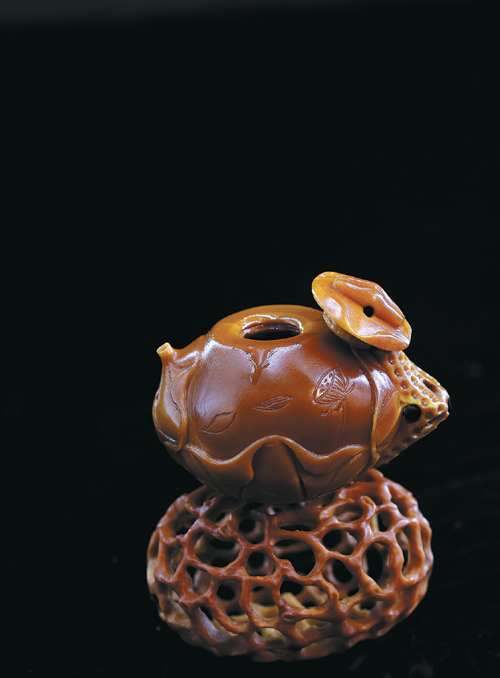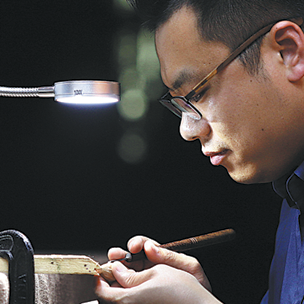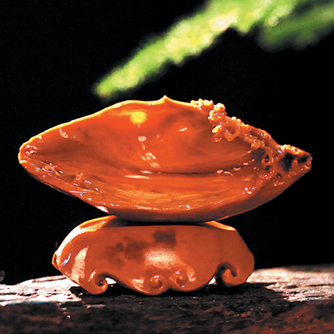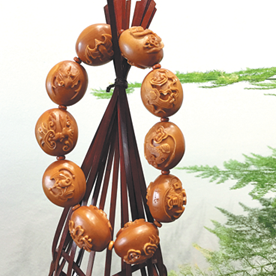An ancient craft makes a comeback
Spurred by strong government support, the delicate art of kernel carving is growing in popularity once again, Qu Yingpu and Xu Xiaomin report in Suzhou, Jiangsu province.

The Story of the Kernel Carving Boat is an essay that many Chinese students would have come across in their textbooks. Written by a Ming Dynasty (1368-1644) scholar, the essay vividly describes the skill required to create a sculpture on a tiny kernel that depicts a boat with passengers, boatmen, a teapot and an oven.
While the original carving is nowhere to be found today, some artisans in Zhoushan village in Suzhou of East China's Jiangsu province have again brought this image of the carving to life with their rendition that was created from an olive kernel.
Xu Jingjian, 36, is one of them.
The intricate sculpture, which measures just 4.5 centimeters in length, took Xu half a year of research and practice, and an entire month to complete.
Boat-themed carvings are considered the epitome of kernel carving in China because of the level of skills needed to execute such an intricate design.
The prices of such artworks start at around 20,000 yuan ($3,112), and those made by master artists, such as Xu's teacher, Xu Zhongying, could be sold for as high as 300,000 yuan.
The art of kernel carving dates back to the Song Dynasty (960-1279) and was especially prevalent in the Ming and Qing (1644-1911) dynasties. People usually hung these kernels on their fans or wore them as fashion accessories or used them to ward off evil spirits.
According to historical records, nearly every rich intellectual during those times owned a folding fan decorated with a kernel carving ornament.
Suzhou has since the Ming and Qing (1644-1911) dynasties been revered for its sophisticated kernel carving works. This is still the case today. In fact, every family in Xu Jingjian's village is engaged in producing intricate artworks from olive kernels.
Professional craftsmen in Suzhou only use a special olive kernel that grows in Guangdong province as it has an even color and is thick enough for complex works to be performed.
Only olive kernels with a shell thickness of over 5 millimeters are selected. Raw kernels will be left to dry for at least three years before they are used, or else artists run the risk of having cracks in the shell during the process of sculpting.
According to Xu Jingjian, the craft of kernel carving received a much-needed boost in 2008 when it was listed as the national intangible culture heritage.
Before that, only elderly craftsmen could be found making such delicate sculptures.
Xu Jingjian himself was not interested in the trade at first-he studied computer technology when he was at school and was eager to join the IT industry as it was more lucrative.
The Suzhou government has invested about 130 million yuan to upgrade Zhoushan village and build a kernel carving gallery, studios and workshops since 2012.
Starting this year, the city will also invest 150 million yuan annually into the promotion of the cultural industries for three consecutive years, says Jin Jie, Suzhou's publicity chief.
"Suzhou's handicrafts reflect the craftsmanship spirit which is centered on determination, patience and the desire to achieve perfection," says Jin.
"The government will have a long-term plan to help promote the development of Suzhou's handicrafts and art."
Another new move by the city to promote this industry is the opening of the Suzhou Art and Craft Gallery at the National Exhibition and Convention Center (Shanghai) to showcase artworks, such as kernel carving, embroideries, fans and fine furniture.
Kernel carving master Xu Zhongying says she is thrilled to have the opportunity to showcase her works in this new gallery.
"Before, I could only do carving at home or in my studio. Now, I am glad to have the support of the government and have a bigger platform to show people my favorite thing in the world," says the 65-year-old.
Because of the strong governmental support and the growing profile of the craft, more young people are flocking to Zhoushan to pick up the skill. Today, there are over 3,000 artisans in the village, and many of them are from the younger generation.
"We are striving to promote the Suzhou-style craft by cultivating young talent and improving the creative designs, and this would help the cultural heritage step out of the old world and don a modern new look," says Sun Jian, head of the Suzhou Taihu National Tourism Vacation Zone, where the village is located.
The influx of young talent has inadvertently brought about a modern approach to promoting the craft of kernel carving.
For example, livestreaming is now a common channel used to sell carvings. This was especially so last year during the COVID-19 pandemic.
Xu Jingjian says some studios can sell as many as 3,000 pieces after a livestreaming promotion.
The younger designers have also brought fresh ideas to the craft, as opposed to merely replicating traditional designs.
Artist Lu Xiaoqin, for example, has made a name for herself after coming up with a unique approach of introducing the element of light to her works.
The 45-year-old's most awarded work is called Sunshine on the Taihu Lake, and it was created by crafting sculptures within the kernel instead of on it. A ray of light shines from the top.
"I have seen more young people become interested in the art form. Their tastes are increasingly diversified and they want to see something different," Lu says.
"This has encouraged me to make more breakthroughs in my work."
Despite increasing competition from the younger artists, veterans like Xu Zhongying have no intention to hang up their tools. She's never worried about she would run out of inspiration.
"Each kernel is different in texture and shape that encourages me to make creations," says the master who has been carving kernel for almost half a century.
"My passion for kernel carving is lifelong. When I sit down, switch on the lamp and start carving with my knives, my mind is totally at peace. The small kernel becomes my world."
Xu Zhongying still does kernel carving seven hours every day.
"And when I am done creating something I am satisfied with, the happiness in my heart is simply beyond description," she says.




Today's Top News
- Wang to meet foreign ministers of Cambodia, Thailand in Yunnan
- China's top legislature concludes standing committee session
- Thailand and Cambodia agree to temporary ceasefire
- NPC's 4th annual session slated for early March
- Civilizational links for a fairer world
- Manufacturing in China spurs global growth






























